Nature and Process of Psychotherapy
- Books Name
- Psychology Book Class-12
- Publication
- PathSet Publications
- Course
- CBSE Class 12
- Subject
- Psychology
Nature and Process of Psychotherapy
- Psychotherapy is a voluntary relationship between the one seeking treatment (client) and the one who treats (therapist).
- The purpose of the relationship is to help the client to solve the psychological problems being faced by her/him.
- The relationship is conducive for building the trust of the client so that problems may be freely discussed.
- Psychotherapies aim at:
- changing the maladaptive behaviours
- decreasing the sense of personal distress
- helping the client to adapt better to her/his environment
- Inadequate marital, occupational and social adjustment also requires that major changes be made in an individual’s personal environment.
- Characteristics of Psychotherapeutic Approaches:
- there is systematic application of principles underlying the different theories of therapy
- persons who have received practical training under expert supervision can practice psychotherapy, and not everybody. An untrained person may unintentionally cause more harm than any good
- the therapeutic situation involves a therapist and a client who seeks and receives help for her/his emotional problems (this person is the focus of attention in the therapeutic process)
- the interaction of these two persons — the therapist and the client — results in the consolidation/formation of the therapeutic relationship. This is a confidential, interpersonal, and dynamic relationship. This human relationship is central to any sort of psychological therapy and is the vehicle for change.
- Goals of Psychotherapy:
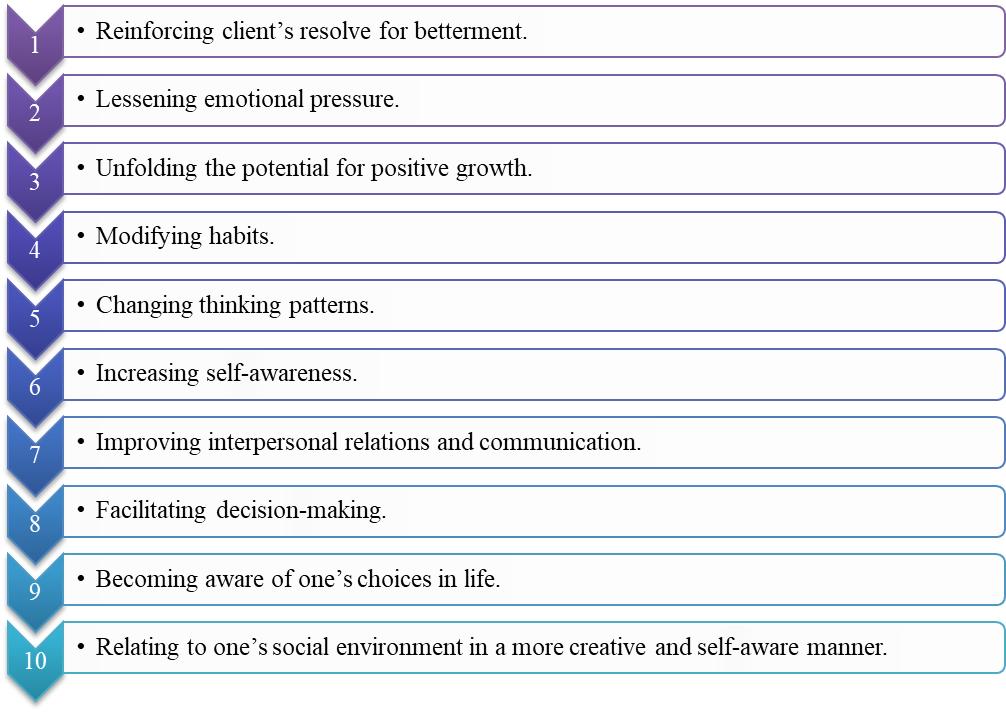
- Therapeutic Relationship or Alliance
- The special relationship between the client and the therapist is known as the therapeutic relationship or alliance.
- It is neither a passing acquaintance, nor a permanent and lasting relationship.
- Two major components of a therapeutic alliance are:
- The contractual nature of the relationship in which two willing individuals, the client and the therapist, enter into a partnership which aims at helping the client overcome her/his problems.
- The limited duration of the therapy. This alliance lasts until the client becomes able to deal with her/his problems and take control of her/ his life.
- Several unique properties of the realtionship are:
- It is a trusting and confiding relationship. The high level of trust enables the client to unburden herself/himself to the therapist and confide her/his psychological and personal problems to the latter.
- The therapist encourages this by being accepting, empathic, genuine and warm to the client.
- The therapist conveys by her/his words and behaviours that s/he is not judging the client and will continue to show the same positive feelings towards the client even if the client is rude or confides all the ‘wrong’ things that s/he may have done or thought about. This is the unconditional positive regard which the therapist has for the client (such as acceptance and respect).
- The therapist has empathy for the client. Empathy is different from sympathy and intellectual understanding of another person’s situation.
- In sympathy, one has compassion and pity towards the suffering of another but is not able to feel like the other person.
- Intellectual understanding is cold in the sense that the person is unable to feel like the other person and does not feel sympathy either.
- Empathy is present when one is able to understand the plight of another person, and feel like the other person. It means understanding things from the other person’s perspective, i.e. putting oneself in the other person’s shoes. Empathy enriches the therapeutic relationship and transforms it into a healing relationship.
- The therapeutic alliance requires that the therapist must keep strict confidentiality of the experiences, events, feelings or thoughts disclosed by the client.
- The therapist must not exploit the trust and the confidence of the client in anyway.
- It must remain a professional relationship.
Type of Therapies
- Books Name
- Psychology Book Class-12
- Publication
- PathSet Publications
- Course
- CBSE Class 12
- Subject
- Psychology
Type of Therapies
Psychotherapies differ greatly in concepts, methods, and techniques.
The classification of psychotherapies into psychodynamic, behaviour, and existential is based on the following parameters:
- What is the cause, which has led to the problem?
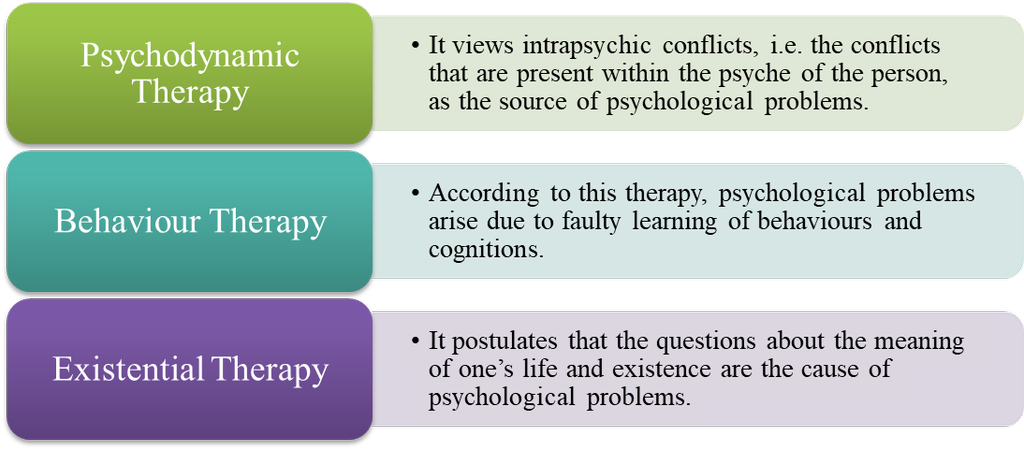
- How did the cause come into existence?
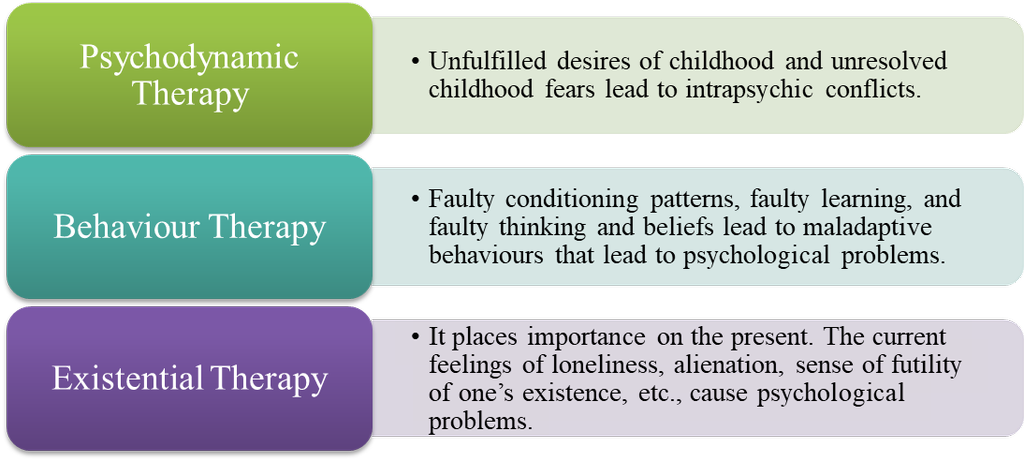
- What is the chief method of treatment?
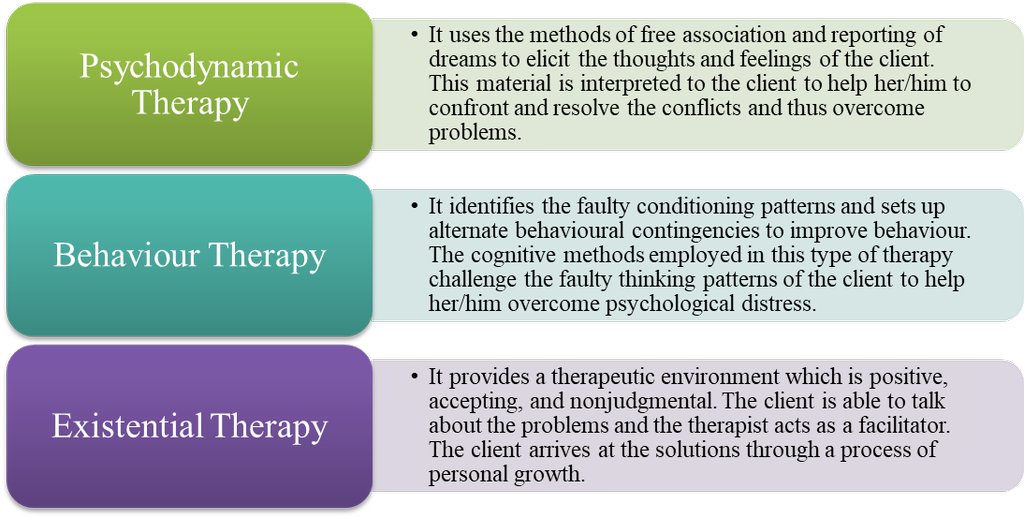
- What is the nature of therapeutic relationship between a client and therapist?
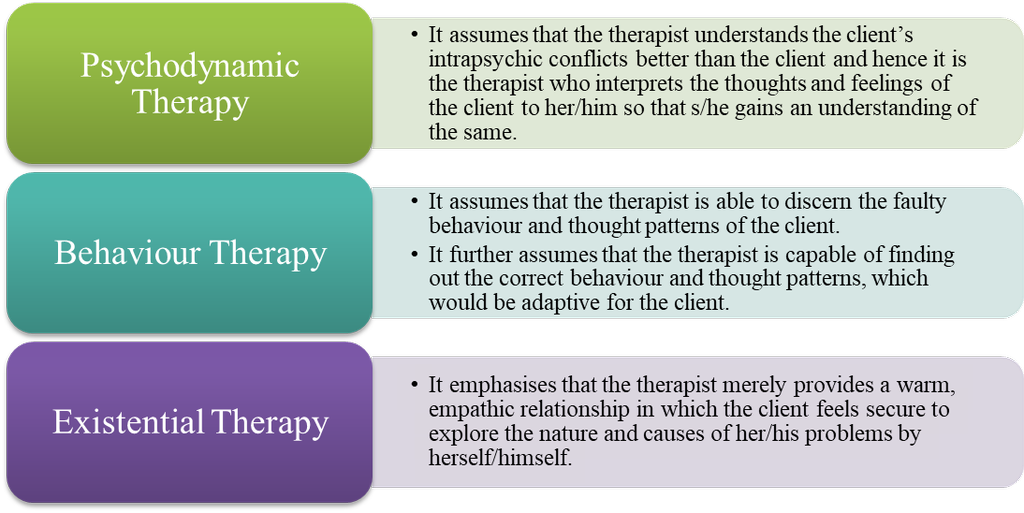
Both the psychodynamic and the behaviour therapies assume that the therapist is capable of arriving at solutions to the client’s problems, in contrast to existential therapy.
- What is the chief benefit to the client?
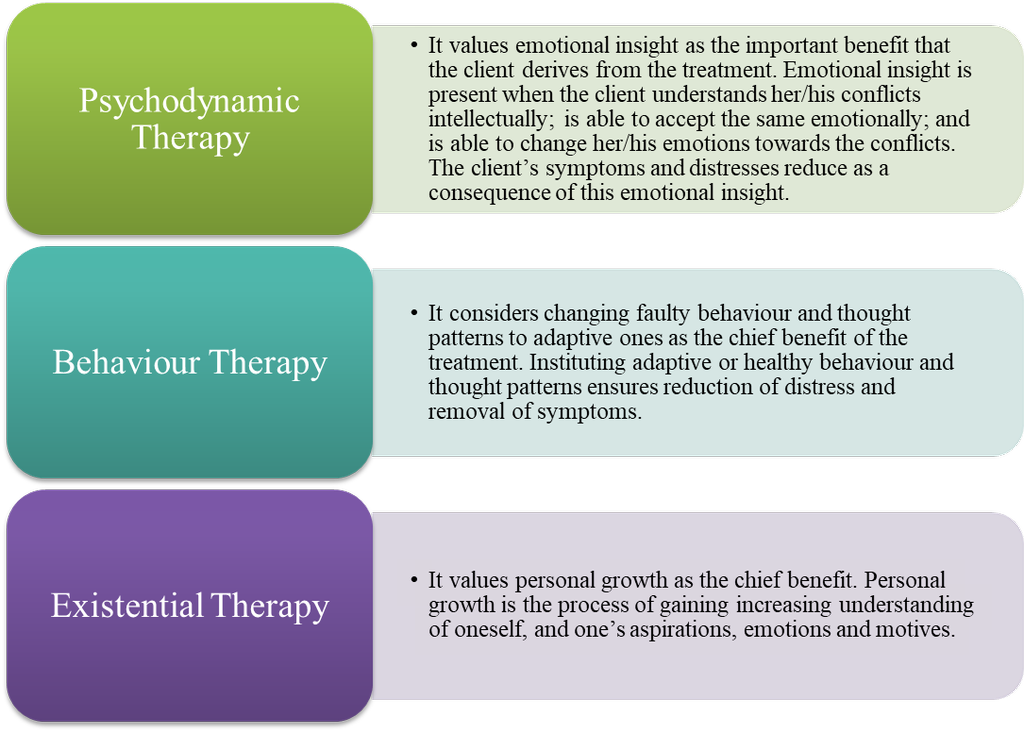
- What is the duration of treatment
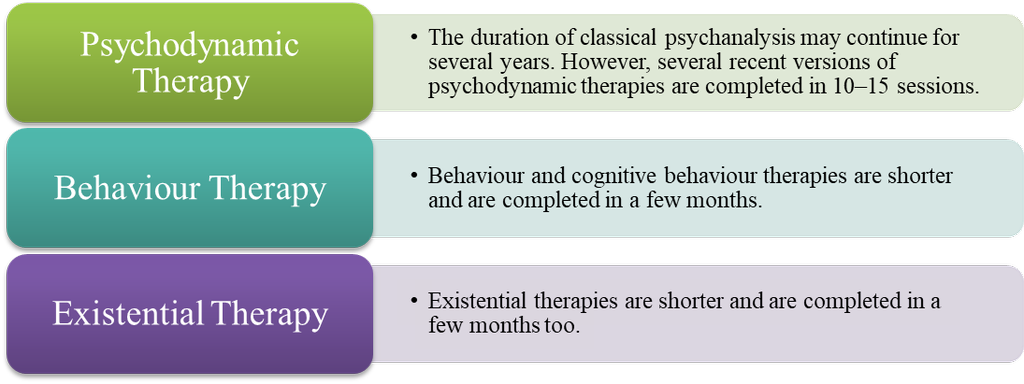
Psychotherapy
- Books Name
- Psychology Book Class-12
- Publication
- PathSet Publications
- Course
- CBSE Class 12
- Subject
- Psychology
Psychodynamic Therapy (pioneered by Sigmund Freud)
- Carl Jung’s modified version of psychodynamic therapy is the analytical psychotherapy.
- Broadly, the psychodynamic therapy has conceptualised the structure of the psyche, dynamics between different components of the psyche, and the source of psychological distress.
- Methods of Eliciting the Nature of Intrapsychic Conflict
Since the psychoanalytic approach views intrapsychic conflicts to be the cause of psychological disorder, the first step in the treatment is to elicit this intrapsychic conflict.
Psychoanalysis has invented two important methods for eliciting the intrapsychic conflicts:
- The Free Association Method
- Main method for understanding the client’s problems.
- Once a therapeutic relationship is established, and the client feels comfortable, the therapist makes her/him lie down on the couch, close her/his eyes and asks her/ him to speak whatever comes to mind without censoring it in anyway.
- The client is encouraged to freely associate one thought with another, and this method is called the method of free association.
- The censoring superego and the watchful ego are kept in abeyance as the client speaks whatever comes to mind in an atmosphere that is relaxed and trusting.
- As the therapist does not interrupt, the free flow of ideas, desires and conflicts of the unconscious, which had been suppressed by the ego, emerge into the conscious mind.
- This free uncensored verbal narrative of the client is a window into the client’s unconscious to which the therapist gains access.
- Dream Interpretation
- The client is asked to write down her/his dreams upon waking up.
- Psychoanalysts look upon dreams as symbols of the unfulfilled desires present in the unconscious.
- The images of the dreams are symbols which signify intrapsychic forces.
- Dreams use symbols because they are indirect expressions and hence would not alert the ego.
- If the unfulfilled desires are expressed directly, the ever-vigilant ego would suppress them and that would lead to anxiety.
- These symbols are interpreted according to an accepted convention of translation as the indicators of unfulfilled desires and conflicts.
Modality of Treatment (Transference and Interpretation are the means of treating the patient)
- Transference
- As the unconscious forces are brought into the conscious realm through free association and dream interpretation, the client starts identifying the therapist with the authority figures of the past, usually childhood.
- The therapist may be seen as the punitive father, or as the negligent mother.
- The therapist maintains a non-judgmental yet permissive attitude and allows the client to continue with this process of emotional identification. This is the process of transference.
- The therapist encourages this process because it helps her/him in understanding the unconscious conflicts of the client.
- The client acts out her/his frustrations, anger, fear, and depression that s/he harboured towards that person in the past, but could not express at that time.
- The therapist becomes a substitute for that person in the present. This stage is called transference neurosis.
- A full-blown transference neurosis is helpful in making the therapist aware of the nature of intrapsychic conflicts suffered by the client.
- There is the positive transference in which the client idolises, or falls in love with the therapist, and seeks the therapist’s approval.
- Negative transference is present when the client has feelings of hostility, anger, and resentment towards the therapist.
- Resistance
- The process of transference is met with resistance.
- Since the process of transference exposes the unconscious wishes and conflicts, thereby increasing the distress levels, the client resists transference.
- Due to resistance, the client opposes the progress of therapy in order to protect herself/himself from the recall of painful unconscious memories.
- Resistance can be:
- Conscious
- the client deliberately hides some information
- Unconscious
- the client becomes silent during the therapy session
- the client recalls trivial details without recalling the emotional ones
- the client misses appointments
- the client comes late for therapy sessions.
- The therapist overcomes the resistance by repeatedly confronting the patient about it and by uncovering emotions such as anxiety, fear, or shame, which are causing the resistance.
- Interpretation
- Fundamental mechanism by which change is effected.
- Two analytical techniques of interpretation are:
- In confrontation, the therapist points out to the client an aspect of her/his psyche that must be faced by the client.
- Clarification is the process by which the therapist brings a vague or confusing event into sharp focus. This is done by separating and highlighting important details about the event from unimportant ones.
- A more subtle process.
- Considered to be the pinnacle of psychoanalysis.
- The therapist uses the unconscious material that has been uncovered in the process of free association, dream interpretation, transference and resistance to make the client aware of the psychic contents and conflicts which have led to the occurrence of certain events, symptoms and conflicts.
- Interpretation can focus on intrapsychic conflicts or on deprivations suffered in childhood.
- Working Through
- The repeated process of using confrontation, clarification, and interpretation.
- Helps the patient to understand herself/himself and the source of the problem and to integrate the uncovered material into her/his ego.
- Insight
- The outcome of working through is insight.
- A gradual process wherein the unconscious memories are repeatedly integrated into conscious awareness; these unconscious events and memories are re-experienced in transference and are worked through.
- As this process continues, the client starts to:
- understand herself/himself better at an intellectual and emotional level
- gain insight into her/his conflicts and problems
- The intellectual understanding is the intellectual insight.
- The emotional insight is:
- emotional understanding
- acceptance of one’s irrational reaction to the unpleasant events of the past
- willingness to change emotionally as well as making the change
- Insight is the end point of therapy as the client has gained a new understanding of herself/himself.
- The client becomes a psychologically healthy person as the conflicts of the past, defence mechanisms and physical symptoms are no longer present.
- Psychoanalysis is terminated at this stage.
Duration of Treatment
- Psychoanalysis lasts for several years, with 1 hour session for 4–5 days per week.
- It is an intense treatment.
- There are three stages in the treatment:
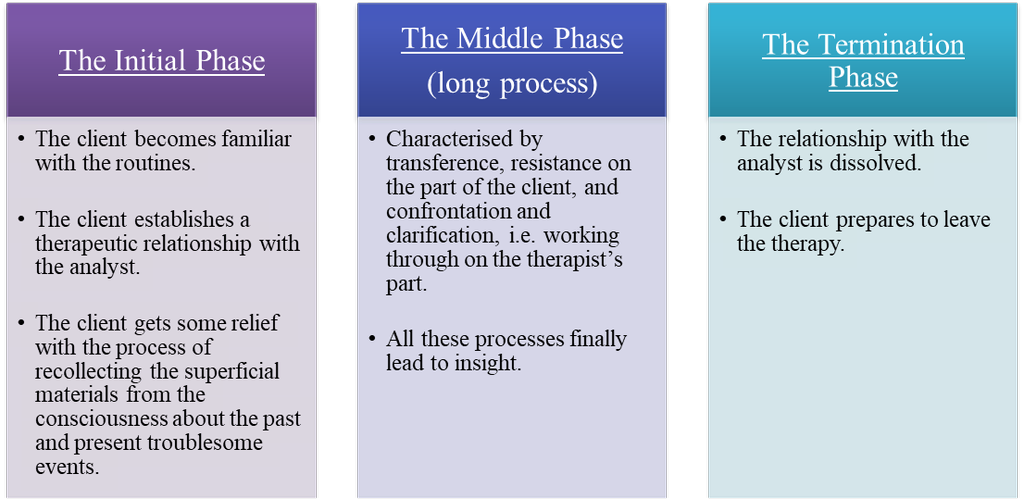
Behaviour Therapy
- It postulate that psychological distress arises because of faulty behaviour patterns or thought patterns.
- Focused on the behaviour and thoughts of the client in the present. The past is relevant only to the extent of understanding the origins of the faulty behaviour and thought patterns. The past is not activated or relived.
- The clinical application of learning theory principles constitute behaviour therapy.
- The symptoms of the client and the clinical diagnosis are the guiding factors in the selection of the specific techniques or interventions to be applied, therefore it is not a unified theory.
- For example,
- Treatment of phobias or excessive and crippling fears would require the use of one set of techniques while that of anger outbursts would require another.
- A depressed client would be treated differently from a client who is anxious.
- The foundation of behaviour therapy is on formulating dysfunctional or faulty behaviours, the factors which reinforce and maintain these behaviours, and devising methods by which they can be changed.
Method of Treatment
- The client with psychological distress or with physical symptoms, which cannot be attributed to physical disease, is interviewed with a view to analyse her/his behaviour patterns.
- Behavioural analysis is conducted to find:
Malfunctioning behaviours
Malfunctioning behaviours are those behaviours which cause distress to the client.
Antecedents of faulty learning
Antecedent factors are those causes which predispose the person to indulge in that behaviour.
Factors that maintain or continue faulty learning
Maintaining factors are those factors which lead to the persistence of the faulty behaviour.
- Once the faulty behaviours which cause distress, have been identified, a treatment package is chosen.
- The aim of the treatment is to extinguish or eliminate the faulty behaviours and substitute them with adaptive behaviour patterns.
- The therapist does this through establishing antecedent operations and consequent operations. Antecedent operations control behaviour by changing something that precedes such a behaviour. The change can be done by increasing or decreasing the reinforcing value of a particular consequence. This is called establishing operation.
Behavioural Techniques
- The principles of these techniques are to:
- reduce the arousal level of the client
- alter behaviour through classical conditioning or operant conditioning with different contingencies of reinforcements
- use vicarious learning procedures, if necessary.
- The skill of the therapist lies in conducting an accurate behavioural analysis and building a treatment package with the appropriate techniques.
- Negative reinforcement (major technique of behaviour modification)
- Responses that lead organisms to get rid of painful stimuli or avoid and escape from them provide negative reinforcement.
- One learns to move away from dangerous stimuli because they provide negative reinforcement. For example, one learns to put on woollen clothes, burn firewood or use electric heaters to avoid the unpleasant cold weather.
- Aversive conditioning (another major technique of behaviour modification)
- It refers to repeated association of undesired response with an aversive consequence.
- For example, an alcoholic is given a mild electric shock and asked to smell the alcohol. With repeated pairings the smell of alcohol is aversive as the pain of the shock is associated with it and the person will give up alcohol
- Positive reinforcement
- If an adaptive behaviour occurs rarely, positive reinforcement is given to increase the deficit.
- For example, if a child does not do homework regularly, positive reinforcement may be used by the child’s mother by preparing the child’s favourite dish whenever s/he does homework at the appointed time. The positive reinforcement of food will increase the behaviour of doing homework at the appointed time.
- Token economy
- Persons with behavioural problems can be given a token as a reward every time a wanted behaviour occurs. The tokens are collected and exchanged for a reward such as an outing for the patient or a treat for the child.
- Differential Reinforcement
- Unwanted behaviour can be reduced and wanted behaviour can be increased simultaneously through differential reinforcement.
- Positive reinforcement for the wanted behaviour and negative reinforcement for the unwanted behaviour attempted together may be one such method.
- The other method is to positively reinforce the wanted behaviour and ignore the unwanted behaviour. This method is less painful and equally effective.
- Systematic desensitisation
- It is a technique introduced by Wolpe for treating phobias or irrational fears.
- The client is interviewed to elicit fearprovoking situations and together with the client, the therapist prepares a hierarchy of anxiety-provoking stimuli with the least anxiety-provoking stimuli at the bottom of the hierarchy.
- The therapist relaxes the client and asks the client to think about the least anxiety-provoking situation.
- The client is asked to stop thinking of the fearful situation if the slightest tension is felt.
- Over sessions, the client is able to imagine more severe fearprovoking situations while maintaining the relaxation.
- The client gets systematically desensitised to the fear.
- The principle of reciprocal inhibition operates here, which states that the presence of two mutually opposing forces at the same time, inhibits the weaker force.
- Thus, the relaxation response is first built up and mildly anxiety-provoking scene is imagined, and the anxiety is overcome by the relaxation.
- The client is able to tolerate progressively greater levels of anxiety because of her/his relaxed state.
- Modelling
- It is the procedure wherein the client learns to behave in a certain way by observing the behaviour of a role model or the therapist who initially acts as the role model.
- Vicarious learning, i.e. learning by observing others, is used and through a process of rewarding small changes in the behaviour, the client gradually learns to acquire the behaviour of the model.
Cognitive Therapy
- It locates the cause of psychological distress in irrational thoughts and beliefs.
- Rational Emotive Therapy (RET) by Albert Ellis
- The central thesis of this therapy is that irrational beliefs mediate between the antecedent events and their consequences.
- The first step in RET is the antecedent-belief-consequence (ABC) analysis.
- Antecedent events, which caused the psychological distress, are noted.
- The client is also interviewed to find the irrational beliefs, which are distorting the present reality. Irrational beliefs may not be supported by empirical evidence in the environment. These beliefs are characterised by thoughts with ‘musts’ and ‘shoulds’, i.e. things ‘must’ and ‘should’ be in a particular manner.
Example “One should be loved by everybody all the time”
- This distorted perception of the antecedent event due to the irrational belief leads to the consequence, i.e. negative emotions and behaviours.
- Irrational beliefs are assessed through questionnaires and interviews.
- In the process of RET, the irrational beliefs are refuted by the therapist through a process of non-directive questioning. The nature of questioning is gentle, without probing or being directive.
- The questions make the client to think deeper into her/his assumptions about life and problems.
Gradually the client is able to change the irrational beliefs by making a change in her/his philosophy about life.
- The rational belief system replaces the irrational belief system and there is a reduction in psychological distress
- Aaron Beck’s Theory
- This theroy of psychological distress characterised by anxiety or depression, states that childhood experiences provided by the family and society develop core schemas or systems, which include beliefs and action patterns in the individual.
For example,
a client, who was neglected by the parents as a child, develops the core schema of “I am not wanted”. During the course of life, a critical incident occurs in her/his life. S/he is publicly ridiculed by the teacher in school. This critical incident triggers the core schema of “I am not wanted” leading to the development of negative automatic thoughts. Negative thoughts are persistent irrational thoughts such as “nobody loves me”, “I am ugly”, “I am stupid”, “I will not succeed”, etc. Such negative automatic thoughts are characterised by cognitive distortions.
Cognitive distortions are ways of thinking which are general in nature but which distort the reality in a negative manner.
These patterns of thought are called dysfunctional cognitive structures which lead to errors of cognition about the social reality.
- Repeated occurrence of these thoughts leads to the development of feelings of anxiety and depression.
- The therapist uses questioning, which is gentle, nonthreatening disputation of the client’s beliefs and thoughts.
Example “Why should everyone love you?”
- The questions make the client think in a direction opposite to that of the negative automatic thoughts whereby s/he gains insight into the nature of her/his dysfunctional schemas, and is able to alter her/his cognitive structures.
- The aim of the therapy is to achieve this cognitive restructuring which, in turn, reduces anxiety and depression.
- Similar to behaviour therapy, cognitive therapy focuses on solving a specific problem of the client. Behaviour therapy is open, i.e. the therapist shares her/his method with the client. It is short, lasting between 10–20 sessions.
- Cognitive Behaviour Therapy (CBT)
- Most popular therapy presently
- Short and efficacious treatment for a wide range of psychological disorders such as anxiety, depression, panic attacks, and borderline personality, etc.
- CBT adopts a bio-psychosocial approach to the delineation of psychopathology.
- It combines cognitive therapy with behavioural techniques.
- The rationale is that the client’s distress has its origins in the biological, psychological, and social realms. Hence, addressing:
- the biological aspects through relaxation procedures
- the psychological ones through behaviour and cognitive therapy techniques
- the social ones with environmental manipulations
- CBT is a comprehensive technique which is:
- easy to use
- applicable to a variety of disorders
- has proven efficacy
Humanistic-existential Therapy
- It postulates that psychological distress arises from feelings of:
- Loneliness
- Alienation
- An inability to find meaning and genuine fulfilment in life
- Human beings are motivated by the desire for personal growth and self-actualisation, and an innate need to grow emotionally.
When these needs are curbed by society and family, human beings experience psychological distress.
- Self-actualisation is defined as an innate or inborn force that moves the person to become more complex, balanced, and integrated, i.e. achieving the complexity and balance without being fragmented.
- Integrated means a sense of whole, being a complete person, being in essence the same person in spite of the variety of experiences that one is subjected to.
- Healing occurs when the client is able to perceive the obstacles to self-actualisation in her/his life and is able to remove them.
- Self-actualisation requires free emotional expression which gets curbed by the family and society as it is feared that a free expression of emotions can harm society by unleashing destructive forces.
This curb leads to destructive behaviour and negative emotions by thwarting the process of emotional integration.
- Therefore, the therapy creates a permissive, non-judgmental and accepting atmosphere in which the client’s emotions can be freely expressed and the complexity, balance and integration could be achieved.
- The fundamental assumption is that the client has the freedom and responsibility to control her/his own behaviour.
The therapist is merely a facilitator and guide. It is the client who is responsible for the success of therapy.
- The chief aim of the therapy is to expand the client’s awareness.
- Healing takes place by a process of understanding the unique personal experience of the client by herself/himself.
- The client initiates the process of self-growth through which healing takes place.
- Existential Therapy
- Victor Frankl, a psychiatrist and neurologist propounded the Logotherapy.
- Logos is the Greek word for soul and Logotherapy means treatment for the soul.
- Frankl calls this process of finding meaning even in life-threatening circumstances as the process of meaning making.
- The basis of meaning making is a person’s quest for finding the spiritual truth of one’s existence.
- There is a spiritual unconscious, which is the storehouse of:
- Love
- Aesthetic awareness
- Values of life
- Neurotic anxieties arise when the problems of life are attached to the physical, psychological or spiritual aspects of one’s existence.
- He emphasised the role of spiritual anxieties in leading to meaninglessness and hence it may be called an existential anxiety, i.e. neurotic anxiety of spiritual origin.
- The goal of logotherapy is to help the patients to find meaning and responsibility in their life irrespective of their life circumstances.
- The therapist:
- emphasises the unique nature of the patient’s life
- encourages them to find meaning in their life
- is open and shares her/his feelings, values and his/her own existence with the client
- reminds the client about the immediacy of the present
- The emphasis is on here and now.
- Transference is actively discouraged.
- The goal is to facilitate the client to find the meaning of her/his being.
- Client-centred Therapy by Carl Rogers
- Rogers combined scientific rigour with the individualised practice of client-centred psychotherapy.
- He brought into psychotherapy the concept of self, with freedom and choice as the core of one’s being.
- The therapy provides a warm relationship in which the client can reconnect with her/his disintegrated feelings.
- The therapist shows empathy, i.e. understanding the client’s experience as if it were her/his own, is warm and has unconditional positive regard, i.e. total acceptance of the client as s/he is.
- Empathy sets up an emotional resonance between the therapist and the client.
- Unconditional positive regard indicates that the positive warmth of the therapist is not dependent on what the client reveals or does in the therapy sessions.
- This unique unconditional warmth ensures that the client feels secure and can trust the therapist. The client feels secure enough to explore her/his feelings.
- The therapist reflects the feelings of the client in a non-judgmental manner. The reflection is achieved by rephrasing the statements of the client, i.e. seeking simple clarifications to enhance the meaning of the client’s statements.
- This process of reflection helps the client to become integrated.
- Personal relationships improve with an increase in adjustment.
- In essence, this therapy helps a client to become her/his real self with the therapist working as a facilitator.
- Gestalt Therapy by Freiderick (Fritz) Perls and Laura Perls
- The German word gestalt means ‘whole’.
- The goal is to increase an individual’s self-awareness and self-acceptance.
- The client is taught to recognise the bodily processes and the emotions that are being blocked out from awareness.
- The therapist does this by encouraging the client to act out fantasies about feelings and conflicts.
Biomedical Therapy
- Medicines
- They may be prescribed to treat psychological disorders but only by qualified medical professionals known as psychiatrists who are medical doctors who have specialised in the understanding, diagnosis and treatment of mental disorders.
- The nature of medicines used depends on the nature of the disorders.
For examples,
- Severe mental disorders such as schizophrenia or bipolar disorder require anti-psychotic drugs.
- Common mental disorders such as generalised anxiety or reactive depression may also require milder drugs.
- The medicines prescribed to treat mental disorders can cause side-effects which need to be understood and monitored. Hence, it is essential that medication is given under proper medical supervision.
- Those drugs which normal individuals use to stay awake to study for examinations or to get a ‘high’ at a party have dangerous side-effects as they can cause:
- Addiction
- Harm to the brain and the body.
Therefore, it is dangerous to self-medicate with drugs which affect the mind.
- Electro-convulsive Therapy (ECT)
- It is another form of biomedical therapy.
- Mild electric shock is given via electrodes to the brain of the patient to induce convulsions.
- The shock is given by the psychiatrist only when it is necessary for the improvement of the patient.
- ECT is not a routine treatment
- It is given only when drugs are not effective in controlling the symptoms of the patient.
Alternative Therapies
- They are alternative treatment possibilities to the conventional drug treatment or psychotherapy.
- There are many alternative therapies such as:
- Yoga
- Meditation
- Acupuncture
- Herbal remedies
- In the past 25 years, yoga and meditation have gained popularity as treatment programmes for psychological distress.
- Yoga
- an ancient Indian technique detailed in the Ashtanga Yoga of Patanjali’s Yoga Sutras
- refers to:
- asanas (body posture component), or
- breathing practices (pranayama), or
- combination of the two
- Meditation
- practice of focusing attention on breath or on an object or thought or a mantra
- here attention is focused.
- Vipasana meditation (mindfulness-based meditation)
- there is no fixed object or thought to hold the attention
- person passively observes the various bodily sensations and thoughts that are passing through in her or his awareness.
- help the patients to process emotional stimuli better and hence prevent biases in the processing of these stimuli
- help with prevention of repeated episodes of depression
- Sudarshana Kriya Yoga (SKY)
- Involves the rapid breathing techniques to induce hyperventilation
- Beneficial, low-risk, low-cost adjunct to the treatment of stress, anxiety, post-traumatic stress disorder (PTSD), depression, stressrelated medical illnesses, substance abuse, and rehabilitation of criminal offenders.
- Has been used as a public health intervention technique to alleviate PTSD in survivors of mass disasters.
- Reduces depression (shown by Research conducted at the National Institute of Mental Health and Neurosciences (NIMHANS))
- Alcoholic patients who practice SKY have reduced depression and stress levels.
- Yoga techniques enhance
- well-being
- mood
- attention
- mental focus
- stress tolerance
- Yoga reduces the time to go to sleep and improves the quality of sleep, hence helping with treatment of insomnia.
- Proper training by a skilled teacher and a 30-minute practice every day will maximise the benefits.
- Kundalini Yoga (taught in the USA)
- Effective in treatment of mental disorders
- Effective in the treatment of obsessive-compulsive disorder (found by The Institute for Nonlinear Science, University of California, San Diego, USA)
- Combines pranayama (breathing techniques) with chanting of mantras.
Factors Contributing to Healing in Psychotherapy
- Major factor in the healing is the techniques adopted by the therapist and the implementation of the same with the patient/client.
For instance, if the behavioural system and the CBT school are adopted to heal an anxious client, the relaxation procedures and the cognitive restructuring largely contribute to the healing.
- The therapeutic alliance, which is formed between the therapist and the patient/client, has healing properties, because of:
- the regular availability of the therapist
- the warmth and empathy provided by the therapist.
- The process of emotional unburdening which is known as ‘catharsis’ has healing properties.
At the outset of therapy while the patient/client is being interviewed in the initial sessions to understand the nature of the problem, s/he unburdens the emotional problems being faced.
- There are several non-specific factors associated with psychotherapy. These factors are called non-specific because they occur across different systems of psychotherapy and across different clients/patients and different therapists.
- Non-specific factors attributable to the client/patient are called patient vairables which include:
- motivation for change
- expectation of improvement due to the treatment
- Non-specific factors attributable to the therapist are called therapist variables which include:
- positive nature
- absence of unresolved emotional conflicts
- presence of good mental health
Ethics in Psychotherapy

Rehabilitation of the Mentally Ill
- Books Name
- Psychology Book Class-12
- Publication
- PathSet Publications
- Course
- CBSE Class 12
- Subject
- Psychology
Rehabilitation of the Mentally Ill
- The treatment of psychological disorders has two components
- reduction of symptoms
- improving the level of functioning or quality of life.
In the case of milder disorders (generalised anxiety, reactive depression or phobia) reduction of symptoms is associated with an improvement in the quality of life.
In the case of severe mental disorders (schizophrenia) reduction of symptoms may not be associated with an improvement in the quality of life.
- Many patients suffer from negative symptoms such as disinterest and lack of motivation to do work or to interact with people.
- Rehabilitation is required to help such patients become self-sufficient.
The aim of rehabilitation is to empower the patient to become a productive member of society to the extent possible.
- In rehabilitation, the patients are given:


 PathSet Publications
PathSet Publications
